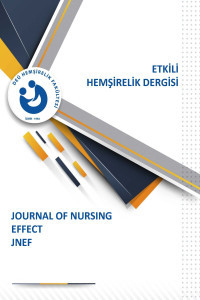Hemşirelik Bölümü Öğrencilerinin Mesleki Güdülenme Düzeyi İle Meslek Algısı Arasındaki İlişki
Anahtar Sözcükler: Hemşirelik, Meslek Algısı, Mesleki Güdülenme, Öğrenci Hemşire.
The Effect of Professional Motivation Level on Perception of Nursing Profession of Nursing Students
Key Words: Nursing, Perception of Nursing Profession, Professional Motivation, Student Nurse.,
___
- Acat, M. B., & Köşgeroğlu, N. (2006). Güdülenme kaynakları ve sorunları ölçeği. Anadolu Psikiyatri Dergisi, 7 (4), 204-10.
- Akbaba, S. (2006). Eğitimde motivasyon. Kazım Karabekir Eğitim Fakültesi Dergisi, 13, 343- 361.
- Al Jarrah, I. A. T. (2013). Associate nursing students’ perceptions toward nursing profession in Jordan. European Scientific Journal, 9(6), 147-166.
- Anderson, E. P. (1993). The perspective of student nurses and their perceptions of professional nursing during the nurse training programme. Journal of Advanced Nursing, 18 (5), 808-15.
- Bernardino, A. O., Coriolano-Marinus, M. W. L., Santos, A. H.S., Cavalcanti, A.M. T. S., & Lima, L. S. (2018). Motivation of nursing students and their influence in the teaching-learning process. Texto & Contexto Enfermagem, 27 (1), 1-10.
- Bronson, S. (2016). Autonomy support environment and autonomous motivation on nursing student academic performance: An exploratory analysis. Nurse Education Today, 44, 103–108.
- Civci, H., & Şener, E. (2012). Hemşire adaylarının mesleki güdülenme düzeyleri ve etkileyen faktörlerin belirlenmesi. Dokuz Eylül Üniversitesi Hemşirelik Yüksekokulu Elektronik Dergisi, 5 (4), 142-9. Retrived September 4, 2018, from http://acikerisim.deu.edu.tr/xmlui/bitstream/handle/12345/4625/civci.pdf?sequence=1&isAllowed=y
- Cook, D. A., & Artino, A. J. (2016). Motivation to learn: an overview of contemporary theories. Medical Education, 50, 997–1014.
- Çelik, S., Şahin, E., Dadak, F., Sıdal, S.G., & Akyüz, F. (2014). Hemşirelik öğrencilerinin mesleki güdülenme düzeyleri ve etkileyen faktörler. Hacettepe Üniversitesi Sağlık Bilimleri ve Mesleki Dergisi, 1 (2), 46-56.
- Çınar Yücel, Ş., Kocaçal Güler, E., Eşer, İ., & Khorshid, L. (2011). İki farklı eğitim sistemi ile öğrenim gören hemşirelik son sınıf öğrencilerinin hemşirelik mesleğini algılama durumlarının karşılaştırılması. Ege Üniversitesi Hemşirelik Yüksekokulu Dergisi, 27 (3), 1- 8.
- Demirkıran, F., Türk, G., & Denat, Y. (2005). İlk klinik uygulama öğrencilerin mesleklerine ilişkin görüşlerini etkiler mi? Ege Üniversitesi Hemşirelik Yüksekokulu Dergisi, Özel Sayı.
- Denat, Y., Gürol Arslan, G., & Şahbaz, M. (2016). Change in students' perception of profession during nursing education in Turkey: a longitudinal study. International Journal of Human Sciences, 13 (1), 900-908.
- Dilekmen, M., & Ada, Ş. (2005). Öğrenmede güdülenme. Kazım Karabekir Eğitim Fakültesi Dergisi, 11, 114-123.
- Dimitriadou, M., Papastavrou, E., Efstathiou, G., & Theodorou, M. (2015). Baccalaureate nursing students' perceptions of learning and supervision in the clinical environment. Nursing and Health Sciences, 17 (2), 236-42.
- Espeland, V., & Indrehus, O. (2003). Evaluation of students, satisfaction with nursing education in Norway. Journal of Advanced Nursing, 42, 226-237.
- Eşer, İ., Khorshid, L., & Denat, Y. (2006). Hemşirelik mesleğini algılama ölçeği geçerlik güvenirlik çalışması. Çınar Dergisi, 10 (1).
- Eşer, İ., Khorshid, L., & Denat, Y. (2008). Hemşirelik mesleğini algılamada ilk klinik uygulamanın etkisi. Ege Üniversitesi Hemşirelik Yüksek Okulu Dergisi, 24 (1), 15-26.
- Gay, L. R. (1996). Educational research (pp.25-30). New Jersey: Prentice-Hall, Inc.
- Gelona, J. (2011). Does thinking about motivation boost motivation levels? The Coaching Psychologist, 7 (1), 42–48.
- Gençay, Ö. A., & Gençay, S. (2007). Beden eğitimi ve spor yüksekokulu öğrencilerinin öğretmenlik mesleğine ilişkin motivasyon düzeylerinin bazı değişkenler açısından incelenmesi. Selçuk Üniversitesi Sosyal Bilimler Enstitüsü Dergisi, 17, 241-253.
- Henderson-King, D., & Smith, M. N. (2006). Meanings of education for university students: academic motivation and personal values as predictors. Social Psychology of Education, 9 (2), 195-221.
- Karasar, N. (2011). Bilimsel araştırma yöntemi (ss.81-82). Ankara: Nobel Akademik Yayıncılık Eğitim Danışmanlık Tic. Ltd. Şti.
- Krejcie, R. V., & Morgan, D. W. (1970). Determining sample size for research activities. Educational and Psychological Measurement, 3, 607-10.
- Kusurkar, R. A., & Croiset, G. (2015). Autonomy support for autonomous motivation in medical education. Medical Education Online [Internet], Retrived July 20, 2018, from http://med-ed-online. net/index.php/meo/article/view/27951
- Kulakçı, H., Kuzlu Ayyıldız, T., Yıldırım, N., Veren, F., & Köse Topan, A. (2015). Motivational resources and problems of nursing students: vocational choice, school culture and other associated factors. Journal of Health and Nursing Management, 2 (2), 83-93.
- Korkmaz, A. Ç., & İpekçi, N. N. (2015). Hemşirelik eğitiminde güdülenme: öğrencilerin içsel ve dışsal güdülenme kaynakları. Sağlık ve Hemşirelik Yönetimi Dergisi, 3 (2), 121-131.
- Köksal, L. G., & Yurttaş, A. (2015). Hemşirelik öğrencilerinin mesleki güdülenme düzeyleri. Balıkesir Sağlık Bilimleri Dergisi, 4 (1), 10-15
- Yayın Aralığı: Yılda 4 Sayı
- Başlangıç: 2008
- Yayıncı: Dokuz Eylül Üniversitesi Hemşirelik Fakültesi
Yoğun Bakım Ünitesindeki Hemşirelik İntörn Öğrencilerin Kaygı Düzeyleri
Dilek ÖZDEN, Şerife KARAGÖZOĞLU, Fatma Tok YILDIZ
Hemşirelik Bölümü Öğrencilerinin Mesleki Güdülenme Düzeyi İle Meslek Algısı Arasındaki İlişki
Yaşlı Bireylerde Bilişsel İşlevlerin Korunmasında ve Geliştirilmesinde Bilişsel Eğitimin Önemi
Merve Aliye AKYOL, Özlem KÜÇÜKGÜÇLÜ
Hüsna ÖZVEREN, Emel GÜLNAR, Esra DOĞAN YILMAZ
Hastaların Ameliyathane Ortamına İlişkin Görüşlerinin İncelenmesi
Tuğçe YEŞİLYAPRAK, Esma ÖZŞAKER
Esra ARBAĞ, Merlinda ALUŞ TOKAT
Yaşlı Kanser Hastalarında Yorgunluk
Hemşirelerin Periferal İntravenöz Kateter Girişimlerine İlişkin Bilgi Düzeylerinin İncelenmesi
Sevgi AYDIN, Gülşah GÜROL ARSLAN
Özge BULDAN, Nevin Kuzu KURBAN
Farklı Kronik Hastalığı Olan Bireylerin Öz-Etkililik Düzeylerinin Karşılaştırılması
